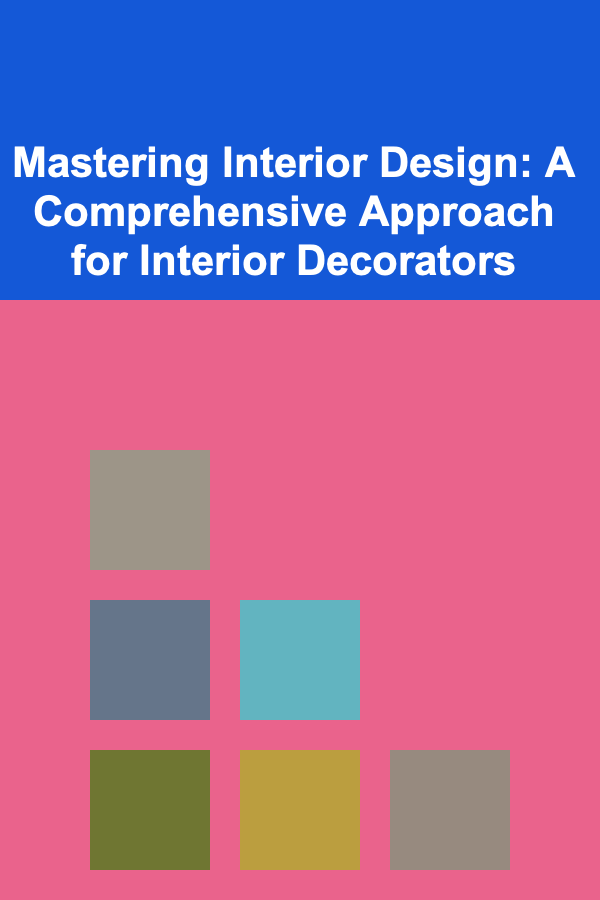
Mastering Interior Design: A Comprehensive Approach for Interior Decorators
ebook include PDF & Audio bundle (Micro Guide)
$12.99$11.99
Limited Time Offer! Order within the next:

Interior design is a dynamic and ever-evolving field that blends art, functionality, and personal expression. For interior decorators, mastering the craft involves understanding not just the visual aspects of design but also the underlying principles that make a space functional, comfortable, and lasting. Whether you're working on residential or commercial projects, a comprehensive approach to interior design can transform a space into something truly remarkable.
In this guide, we'll explore actionable strategies and in-depth insights for mastering interior design. From understanding the fundamentals of design principles to implementing sustainable practices, this guide provides a holistic approach for interior decorators to excel in their craft.
Understanding the Core Principles of Interior Design
Before diving into any design project, it's essential to have a clear understanding of the core principles that form the foundation of good design. These principles will guide every decision you make and ensure a cohesive and functional outcome.
Balance
Balance refers to the distribution of visual weight in a space. It helps create a sense of stability and order, and it can be achieved in several ways:
- Symmetrical Balance: This involves creating a mirror image of elements on either side of a central axis. Symmetry is often used in traditional designs, creating a formal and harmonious feel.
- Asymmetrical Balance: This type of balance uses unequal elements to create visual interest and a more relaxed, informal atmosphere. Asymmetry can be dynamic and modern.
- Radial Balance: Elements are arranged around a central point, creating a circular, radiating design. This approach is often seen in round dining tables or feature ceilings.
Proportion and Scale
Proportion and scale refer to the relationship between the size of objects and their surroundings. These elements are crucial in ensuring that the design doesn't feel overcrowded or too sparse.
- Scale: This refers to the size of furniture or objects in relation to the space they occupy. For example, a large sofa might overwhelm a small room, while a tiny chair might look out of place in a spacious living room.
- Proportion: Proportion deals with the ratio between different elements. For instance, pairing large furniture pieces with equally large accessories ensures visual harmony.
Rhythm
Rhythm in interior design is about creating patterns of repetition and contrast that guide the eye through a space. Just as rhythm in music creates movement, rhythm in design directs how one moves visually from one part of the room to the next.
- Repetition: This involves repeating colors, patterns, or shapes in different parts of the room to create unity.
- Progression: A gradual increase or decrease in size or color intensity can create a sense of movement. For example, using lighter tones in the foreground and darker tones in the background gives a sense of depth.
Emphasis
Emphasis is about creating focal points in a space. Every room should have an element that draws attention, whether it's a piece of artwork, a unique piece of furniture, or an architectural feature like a fireplace.
- Contrasting Color: Bold color choices can draw attention to specific areas or items in a room.
- Lighting: Well-placed lighting can highlight key elements and create a sense of drama or focus.
Harmony
Harmony in interior design refers to the pleasing combination of different elements within a space. It's about creating a unified look where all elements complement each other rather than compete for attention.
- Complementary Colors: Using colors that are opposite each other on the color wheel creates visual interest while maintaining balance.
- Texture Variations: Mixing soft and hard textures, such as velvet with metal, creates a harmonious contrast that adds depth to a space.
Creating a Vision: Designing Around Purpose
Every room in a home or commercial space serves a specific function, and great design begins with understanding how the space will be used.
Defining Function
- Living Spaces: Living rooms, lounges, and entertainment areas need to be cozy yet functional. Choose furniture that encourages conversation and relaxation. Large sofas, coffee tables, and a focal point like a fireplace or entertainment system work well in these spaces.
- Workspaces: Home offices or commercial workspaces need to prioritize productivity and ergonomics. Adjustable desks, comfortable chairs, and well-organized storage are essential for maintaining an efficient work environment.
- Private Spaces: Bedrooms, bathrooms, and other private areas should focus on comfort and relaxation. Choose calming colors, soft textiles, and functional furniture that enhance the room's comfort and intimacy.
- High-Traffic Areas: Hallways, entryways, and kitchens need durable, low-maintenance materials. These areas should be both welcoming and functional, allowing easy movement while maintaining style.
Flexibility and Adaptability
The best designs anticipate future changes. Spaces should be designed with adaptability in mind, allowing for modifications as needs evolve.
- Multi-Functional Furniture: In smaller spaces, choose furniture that serves multiple purposes. A sofa that converts to a bed, an ottoman with hidden storage, or a foldable dining table can provide flexibility as the use of the space changes.
- Modular Designs: Modular furniture systems allow for easy rearrangement. This is particularly useful in spaces that serve various functions over time, such as guest rooms that transition into offices.
The Art of Color and Light
Color and lighting are two of the most important design elements. They have a profound impact on the mood of a room and how people feel within it.
Choosing the Right Color Palette
- Neutral Colors: These colors provide a timeless and versatile foundation for any room. Whites, grays, and beiges are perfect for creating a calm and serene atmosphere. They also provide flexibility for accent colors.
- Accent Colors: Use bold or contrasting colors for focal points---whether through artwork, furniture, or textiles. These colors inject energy and personality into a space.
- Monochromatic Schemes: Using variations of a single color can create a sophisticated and cohesive look, allowing for a more understated yet visually appealing design.
Lighting Strategies
Lighting can completely transform the feel of a space. The right lighting can highlight features, create ambiance, and improve functionality.
- Ambient Lighting: The primary source of light in any room, usually provided by overhead fixtures or lamps. Consider using dimmers to adjust the light according to the time of day or mood.
- Task Lighting: Direct light focused on specific areas for tasks like reading, cooking, or working. Desk lamps, under-cabinet lighting, and adjustable reading lights are examples.
- Accent Lighting: Used to highlight artwork, architectural details, or features like plants. It adds visual interest and depth to a space.
Layered Lighting
Combine different types of lighting (ambient, task, accent) to create depth and flexibility. Layering allows you to control the mood and functionality of the room, adjusting it for different activities and times of day.
Choosing the Right Furniture and Materials
Selecting the right furniture and materials is integral to the success of any interior design project. Furniture should not only reflect the style but also be functional, durable, and comfortable.
Furniture Selection
- Comfort and Ergonomics: Whether it's a sofa, chair, or office desk, prioritize comfort and ergonomic design. Furniture should support the physical needs of the space's users.
- Quality over Quantity: Invest in key pieces of furniture that will stand the test of time. Avoid overcrowding a room with excessive furniture. Instead, select timeless, durable items that serve multiple functions.
- Proportions: As mentioned earlier, the size and scale of furniture should suit the room. In small spaces, consider sleek, minimal furniture to avoid overwhelming the space.
Materials and Textures
- Natural Materials: Wood, stone, and metal are timeless materials that bring warmth and texture to a space. These materials also provide longevity and sustainability when sourced responsibly.
- Sustainable Choices: As eco-consciousness grows, many interior designers are turning to sustainable materials, such as recycled glass, bamboo, and non-toxic paints and finishes.
- Soft Textiles: Soft furnishings like pillows, rugs, and throws can add comfort and warmth to any space. Play with texture combinations to create a more inviting and tactile environment.
Sustainability in Interior Design
Sustainability is an increasingly important consideration in interior design. By using eco-friendly materials, designing for energy efficiency, and focusing on durability, interior decorators can create spaces that have a minimal environmental impact.
Eco-Friendly Materials
- Recycled and Reclaimed Materials: Recycled furniture, reclaimed wood, and repurposed materials not only reduce waste but also add character and charm to a space.
- Non-Toxic Finishes: Choose paints, finishes, and fabrics that are free from harmful chemicals. Many brands now offer non-toxic, low-VOC (volatile organic compound) options that improve indoor air quality.
- Energy Efficiency: Incorporate energy-efficient lighting and appliances, as well as proper insulation and window treatments, to reduce a home's carbon footprint.
Long-Term Design
A sustainable approach also involves creating timeless designs that don't require frequent updates or replacements. Choose quality pieces that will stand the test of time and avoid trends that may go out of style quickly.
Personalization and Client-Centric Design
A space should reflect the personality and preferences of its inhabitants. Personalization is what turns a room from just a functional space into a home.
Client-Centric Approach
- Understand the Client's Needs: Whether it's a family home or a corporate office, understanding the specific needs of your client is essential. Ask questions about their lifestyle, habits, and preferences to guide your design decisions.
- Incorporate Personal Touches: Personalize the space with elements that reflect the client's individuality---this could be through artwork, unique furniture pieces, or a curated collection of items that hold personal significance.
Conclusion
Mastering interior design requires more than just an eye for beauty. It demands an understanding of functionality, a deep knowledge of design principles, and a thoughtful approach to personalization. By combining creativity with practicality and sustainability, interior decorators can create spaces that are not only visually stunning but also comfortable, functional, and timeless. Whether you're designing a home or a business, following a comprehensive approach will ensure you achieve designs that truly make an impact.

How to Build a Strong Neighborhood Watch Program for Better Security
Read More
How to Create a System for Managing Camp Registration
Read More
How to Keep Your Car Organized for Family Trips
Read More
How to Make Money Online as a Non-Profit Consultant: 10 Actionable Ideas
Read More
How to Monetize Deep Learning Models in the Digital Marketplace
Read More
How to Prevent Home Invasions by Securing Your Backyard
Read MoreOther Products

How to Build a Strong Neighborhood Watch Program for Better Security
Read More
How to Create a System for Managing Camp Registration
Read More
How to Keep Your Car Organized for Family Trips
Read More
How to Make Money Online as a Non-Profit Consultant: 10 Actionable Ideas
Read More
How to Monetize Deep Learning Models in the Digital Marketplace
Read More